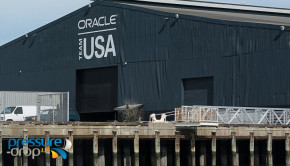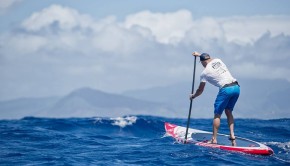Nevin Sayre – Broadening the scope of junior programs
Published on November 21st, 2010
 (November 21, 2010) Before Nevin Sayre was a five-time U.S. National Windsurfing Champion, he was a four time college sailing All-American. Sayre not only understands the competitive side of sailing, he understands that competition isn’t what sailing is all about.
(November 21, 2010) Before Nevin Sayre was a five-time U.S. National Windsurfing Champion, he was a four time college sailing All-American. Sayre not only understands the competitive side of sailing, he understands that competition isn’t what sailing is all about.
So it is no shock to him that the sport in the U.S. is struggling to turn youth sailors into life sailors, because the focus in most junior programs is to turn youth sailors into youth racers. Here he explains:
Part One
In general, most junior sailing programs are one-dimensional and therefore limiting. There is the successful competitive track of prams/ Lasers/ 420s/ FJs that is great for the kids who are really into racing, but hardly inspiring for a larger group of “other kids”. The percentage that is exposed to sailing at age 6-10 but is effectively out of sailing by age 22 is staggering. Yeah, we point to large junior fleets and growing collegiate and high school sailing (which is awesome!), but this is usually the cream of the racer crop, and most others have checked out. Should our junior programs be teaching racing? Or sailing? We owe it to our sport to offer inspiring sailing alternatives for the “other kids”.
When juniors are asked why they dropped out of sailing, I find the real answers break down into three main issues: 1) boring compared to other activities; 2) over focus on racing/results; and in some cases because 3) “it was scary”. For most competitive sailors this is difficult to swallow. We love the tactics of racing, and the measurement against our peers is part of the excitement. We are enthused by the chess game, even if the boats are not particularly exciting. We can handle ourselves when the coach boat is not close by, and we are rarely scared. We wonder why the kids who drop out – the “other kids”- don’t get it.
Let’s be honest. The boats we learned to sail in may have been cutting edge at the time, but we introduce most new kids to sailing in boats that were designed over 50 years ago, (particularly in the U.S.). While lots of adult excitement surrounds new sport boats, multihulls, foilers, windsurfers, and kites, we stick our kids in bathtubs with archaic rigs and think it’s fine. The bathtubs might be okay for the first lessons, but sometimes kids are stuck in them for six years before they are physically ready to handle the next level boat. Many of these kids are bored out of their minds, and the dropout rate at age 10-13 is particularly high. This is the age when kids start to exercise their own choice, rather than just go where Mom & Dad signs them up. We are teaching the palm texting generation how to sail with typewriters. If the kids don’t like typewriters, they’re gone.
No doubt, most of us would find enjoyment in racing One Design Typewriters, but unless you are a kid who loves the game of racing, there’s not much inspiration. How often do kids take out the boats in your junior program just for fun? Where I live they leave the beach only when it’s an organized class or race. After class, they take out the windsurfers and other modern alternatives to go have a good time. That says a lot.
 Almost the first thing most junior sailing programs do is set buoys, blow whistles, and start barking race rules. Only natural…… most of the summer instructors come from college racing and grew up with one option. Very soon the kids are ranked and measured against their peers. The kids at the top are fine with that, but the kids toward the back – not so much. The rankings are promoted (pushed?) by the coaches and often the parents, and a lot of kids tune out. In a lifetime sport that offers a myriad of wonderful options for adults, and where only a minority are involved in round-the-buoys competition, it’s too bad that usually the entire focus in junior sailing is on this one dimension.
Almost the first thing most junior sailing programs do is set buoys, blow whistles, and start barking race rules. Only natural…… most of the summer instructors come from college racing and grew up with one option. Very soon the kids are ranked and measured against their peers. The kids at the top are fine with that, but the kids toward the back – not so much. The rankings are promoted (pushed?) by the coaches and often the parents, and a lot of kids tune out. In a lifetime sport that offers a myriad of wonderful options for adults, and where only a minority are involved in round-the-buoys competition, it’s too bad that usually the entire focus in junior sailing is on this one dimension.
With all the coach and mommy boats hovering around, I’m guessing the third reason kids drop out from sailing – “it’s scary”- is a less frequent cause. Nevertheless, time and again you hear about the kid who freaked out when the boat filled with water, was terrified, and quit cold turkey. Fortunately there are modern junior boats now available that are self-rescuing.
Part Two
Sailing could learn a lot from the history of the snow industry. There was a time when archaic long skis were strapped on to a kid’s boots and he/she was shown primarily one option. If they made it through basic training, most kids were introduced to gates and racing was the one game to play. Snow sports at that time were on the fringe. Then came a revolutionary new era in the mountain industry, inspired by snowboarding, technology, innovation, and new materials. A combination of modern equipment, new formats, and style made snow sports (boarding and modern skiing alike) attractive to kids. The gear and culture was COOL and junior programs started to offer new alternatives for free riding, freestyle, etc for the kids who weren’t inspired by the same one format their parents were weaned on.
And you know what? There was still probably the same number of racers, but snow sports became attractive to “other kids”, and participation numbers went through the roof! Would the explosion of snow sports have happened if kids were introduced to skiing with gear from 50 years ago and racing gates was the only focus of every junior program?
So why is sailing so popular in, say, a country like France? One of the reasons has got to be that kids in France are as likely to learn to sail on a windsurfer or multihull or skiff as they are in an old school dinghy. Kids are given modern gear and can choose alternative formats that they find attractive. More kids become passionate about sailing.
The U.S. has been particularly slow in changing its one-dimensional thinking, but it is encouraging to see more junior programs are finding new alternatives that strike a chord with the “other kids”. More and more programs now offer windsurfing and recreational “Reachers” programs with low emphasis on race results and a stronger focus on sailing a variety of different modern boats. Instead of going around buoys until the kids are dizzy, on a given day they might borrow a big boat, try windsurfing, practice freestyle sailing, or “adventure sail” to a different harbor for ice cream. They are getting a wide range of valuable sailing skills, and, like at the mountain, the experience is more about hanging with their buds – doing the sport with each other and not always against each other.
Not surprisingly, it is often the community sailing programs that are taking the lead in offering new alternatives. They can’t rely on Mom & Dad’s club membership to guarantee a pool of kids who will at least try sailing. The community programs need to make sailing more fun and attractive to the “other kids” outside, or else they die. You can always find that the most vibrant programs are the ones that offer alternatives to the conventional race track. Community programs (and usually the parents) are usually not so focused on race results and filling the trophy cabinet. They are generally more open to try new thinking, but often have a tighter budget.
Don’t get me wrong. The pram/ Laser/ 420/ FJ race track may be just fine for a lot of kids, but junior programs that have added more fun, new-age alternatives are now reporting more enthusiasm and their dropout rates are in decline. Not every mountain allowed snowboarding or new-school skiing in the beginning, but when they saw the lines of kids flocking to the fun, they came around.
For full disclosure I work with BIC Sports that offers two junior alternatives – the O’Pen BIC and Techno 293 windsurfer. I am an avid windsurfer, dinghy sailor, and kitesurfer. While this combination certainly makes me biased, my passion stems from being a life-long sailor who witnessed my own two kids and their friends go through junior sailing programs … or drop out.








 We’ll keep your information safe.
We’ll keep your information safe.